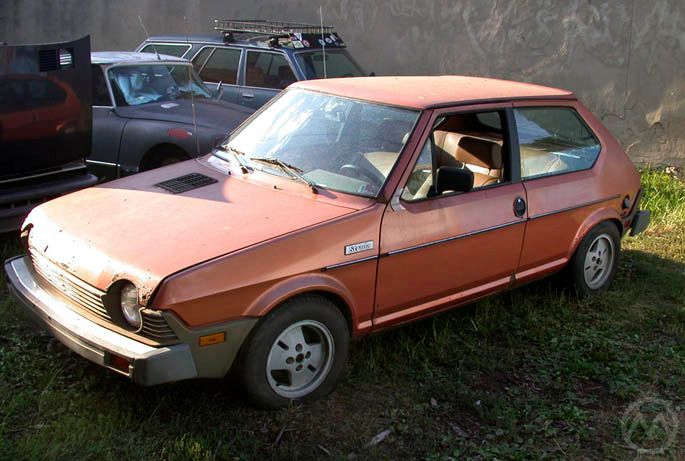Long forgotten by most in America, the Fiat Strada – called the Fiat Ritmo in Europe – was delightfully strange and very familiar at the same time.
Sometimes accused of being a copy of the VW golf, underneath it was mostly a Fiat 128 – a car the Golf had emulated. Famously (infamously?) “Built by Robots,” the Strada was let down by abysmal quality control. Things got better as the car soldiered on in Europe, but the early cars had a rough go of things – and Fiat bailed on the U.S. in early 1983.
Primula to Ritmo
The Strada’s story begins with the Fiat 128, itself built on ideas that Fiat proved out using the Autobianchi Primula starting in 1964. This was Fiat’s first front-drive, transverse-engined design, using unequal-length driveshafts and a side-on gearbox.
Inspired by the Mini, this arrangement was more practical and robust than BMC’s earlier setup. Still, to be careful Fiat tested the waters with the low-profile Autobianchi before moving the system to it’s bread and butter models.
The Fiat 128, 1970’s European Car of the Year, was a massive success and a great car to drive – rev-happy and fun if a bit small. Suspended by four struts and using a modern FF layout like the Primula, the 128 was a blueprint for many subsequent small cars. This included the VW Golf, which had blended some of the best bits of the 128, 127 and the Simca 1100.
The Golf proved hugely popular, seemed better made than the Fiat, and also offered larger engines and automatics. The Fiat 128 was actually never offered with an automatic in any market – hard to believe in these days of “endangered” manuals.
The Golf’s huge success, and the popularity of the Fiat 127’s hatchback led Fiat to want a 128-sized or slightly larger hatchback of its own. Work began on that project in late 1972, even before the Golf.
Sergio Sartorelli
Leading the style effort was Sergio Sartorelli, a veteran of Luigi Segre-era Ghia. Sartorelli had designed, for Ghia, the Fiat 2300S and Volkswagen Type 3 Karmann-Ghia, among other things.
Sartorelli had left Ghia for OSI, where he designed the sexy OSI-Ford 20M TS, but OSI was eventually absorbed into Fiat. Sartorelli’s first major Fiat project was the 126.
Sartorelli was quite versatile, and the Strada/Ritmo didn’t really look like anything else he’d done before. It’s sharp styling was chock-full of 1970s futuristic flourish. You could easily see Sartorelli heading down to the bookstore to pick up a copy of Charles Jencks’ “The language of postmodern architecture” when it came out in 1977.
The European and North American cars diverged quite a bit. Euro models got flush-mounted gray plastic bumpers with almost minimalist detail work. The door handles were round units like portholes. The interior was a swath of modern plastic and red-and-green coded toggle switches. This style was cut from the same (probably orange) 1970s cloth as cars like the Rover SD1 or Citroën CX – futuristic and modern.
Something Old and Something New
Underneath though, those cars were mostly new and the Strada really wasn’t. The 128 was still bang up to date in terms of dynamics and technology. Even in the 1980s (production lasted into 1985) it was still a good car to drive. Much of the 128 was retained in the new car (and in the related Lancia Delta).
At first, the Strada/Ritmo had an internal numerical code like all 1970s Fiats. When the cars arrived, they surprisingly got names instead of numbers. In North America and the U.K., the Strada name (later applied to a pickup) was used. Everywhere else it was the Ritmo – Italian for “Rhythm.”

The 128’s excellent mechanical pieces served the Ritmo well. It was light but responsive, with great handling just like its predecessor. It had a softer ride than the 128 but the same revvy 128-derived SOHC engines. Like Fiat’s more famous twin-cam, this engine family was designed by Aurelio Lampredi.
Many models were offered in Italy and continental Europe, ranging from humble 1.1L econoboxes to twin-cam Abarths and, eventually, rather substantial diesels, but in the U.S., all Stradas shared their 1,498-cc Single-cam with the X1/9.
North America
The North American models were quite unlike the Euro cars in appearance, too.
Instead of the plain, modern flush bumpers, U.S. cars had blunt, rail-like impact bumpers integrated into the front and rear fascias. This added weight and definitely detracted from the car’s appearance, and made them look even more like the Rabbit (VW’s North American Golf), which had similar giant bumpers.
The big bumpers were good for urban parking, but not much else, and a majority of American consumers don’t parallel park every day.
U.S. Stradas could have a five-speed or an optional Automatic (availability was slow initially, this gearbox was ironically supplied by Volkswagen), both a big upgrade from the 128’s four-speeder. The fifth gear and extra displacement made the Strada an appreciably better highway car than the outgoing 128.
Introduced just in time for the 1979 OPEC crisis, the Strada bowed to decent reviews had a good first 18 months in the U.S. and then quickly sank. The cars were let down by abysmal quality control and rust. To be fair, even before the Strada arrived things were not great. Fiat’s sales momentum – strong in the late 1960s and early 1970s – had been blunted by consumer’s experiences with spotty quality control and indifferent service.
Word had gotten around that Fiat just couldn’t match VW or Datsun on quality even if, thanks to exchange rates, it often had a distinct pricing advantage. Sales began to slack off in 1980 and were way down for 1981.
In 1982, Fiat fielded only the Strada and it’s two sports cars – the Spider and X1/9 – in the U.S., but mostly it was selling leftover ‘81s. After much speculation, Fiat withdrew from the U.S. in January, 1983 – leaving behind the sports cars via their constructors and specialist importers.
This more or less annihilated any resale value non-sporty Fiats had, which wasn’t much in the first place. Most of the cars were used up quickly – they were after all economy cars. By the end of the 1980s they were becoming rare. By 2001, when this photo of the silver car above was taken, they were hen’s teeth.
About 40,000 Stradas were sold stateside, but probably less than 300 are still around.
The Strada/Ritmo earned itself an awful reputation but the basic design was quite sound. The cars did far better once rust protection and assembly quality improved with the second-series cars introduced in 1982.
Europe also got the very desirable Abarth 105/125/130TC models, a proper hot hatch sporting twin-cam power. These were introduced right around the time Fiat was clocking out in the U.S.
The silver car is long gone now, but the orange one survives in the hands of Fiat collector and friend of Old Motors Shaun Folkerts. When these pictures were taken, both belonged to friend of Old Motors Dan R.

